February 26, 2024.
Not to be confused with the world-famous Beaver Tails that originated in nearby Killaloe, we
 have our own version of beaver "tales". A series of events
similar to Bill Murray’s battle with the groundhog in the
movie "Caddyshack". Our nuisance rodent is the very
determined beaver.
have our own version of beaver "tales". A series of events
similar to Bill Murray’s battle with the groundhog in the
movie "Caddyshack". Our nuisance rodent is the very
determined beaver.
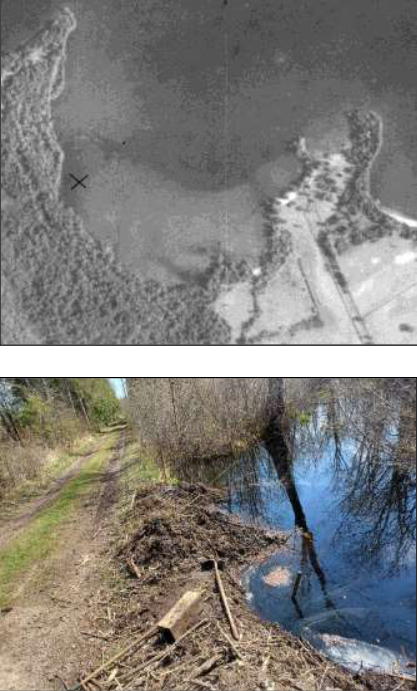
Before Sleepy Hollow Lane was built, the area was covered with mature trees, as can be seen in this air photo from 1936. The area was drained by natural runoff and a small creek about 1,000 feet from our current property. Sleepy Hollow Lane was built in the 1960s to provide access to new cottage properties along Harris Bay. A large concrete culvert was installed to bridge the creek, providing access from the Bonnechere Lodge Road to Skelly Road. The lane was a rudimentary dirt road, as can be seen in the pictures below. Privately owned and unmaintained, it formed a dyke with drainage for the spring runoff directed to the creek. With the advent of GPS in later years, many visitors, delivery truck drivers and even a fully loaded cement truck heading for Skelly Road, found themselves routed along Sleepy Hollow Lane. Unsure of what to do when faced with a narrow, muddy road, they would stop and consult their maps or call their friends for advice.
Perhaps a sign saying, "Your GPS is Wrong – Turn Around", would help.
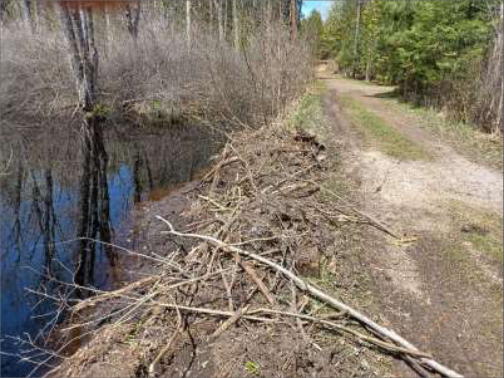
One year, an enterprising beaver
built a retirement home back in the
bush and decided to increase his
waterfront recreational area by
damming the culvert. This set up an
ongoing battle with the adjacent
property owner to keep the culvert
open in the spring. My wife, Sandy,
and I, would often walk down with
rakes in hand and help out with the
culvert maintenance. This would be
a daily exercise because the beaver
would spend the next night
repairing the break in his dam.
One day, I was lying face down on
the road reaching into the inlet of
the culvert with a garden cultivator,
clearing out debris, when my cell phone
rang. I had to pause my maintenance
duties to field a call from a Facebook
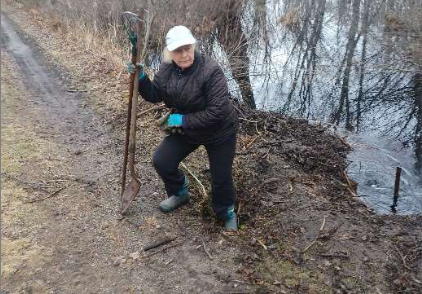 Marketplace customer wanting to buy a
stove we had for sale. Life goes on, I sold
that stove and continued raking out the
debris.
Marketplace customer wanting to buy a
stove we had for sale. Life goes on, I sold
that stove and continued raking out the
debris.
On another occasion, Sandy and I were working at the inlet, when we heard a tremendous splash at the outlet. Thinking it was the beaver, we checked to find three large pike in the shallow water. One had tried to climb over the road but fell back into the water. We completed our cleanout of the inlet and hopefully the fish were free to spawn. Apparently pike spawn in the last two weeks of May, when the ice is off the lake. They like slow moving, marshy areas, with muddy bottoms and look for flooded areas in the spring. Often these areas are dry later in the summer.
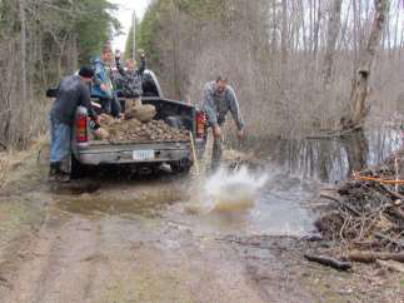
When the spring runoff was over and the water had receded, the beaver abandoned his nightly damming operations and the battle was over for another year. One spring he did cause a washout that required some repair from my reserve rockpile.
After an extremely dry season in the
summer of 2012, we were faced with a
different beaver battle. Early in
November we noticed some downed trees
along the waterfront and, on further
investigation, we found that a busy
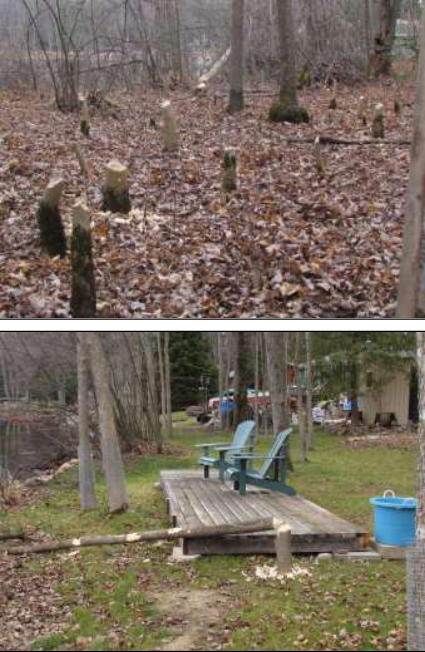 beaver had felled about 35 trees.
He was building a lodge in the lake, about
1,500 feet further up the shore.
beaver had felled about 35 trees.
He was building a lodge in the lake, about
1,500 feet further up the shore.
The next week the downed tree count was over 50, and two weeks later up to 150. Half of these were saplings but the other half were good sized trees, four to eight inches in diameter. He was clear-cutting everything in his way; especially the ones along the shoreline that any good environmentalist knows have to be preserved. Only evergreens were safe while willow, poplar, birch, ash and maple were fair game. He even ventured onto our developed area and had the audacity to drop a tree across a deck before proceeding to section it for transport home.
We spent the next two weekends wrapping the few trees we had left with chicken wire and heavier mesh to discourage him. I was told that wrapping the trees in green plastic would also work as his dim mind would think it was an evergreen. I even did him a favor and pushed down a large tree that was snagged. That night he cut it in three-foot sections, but at least it gave temporary reprieve to other trees.
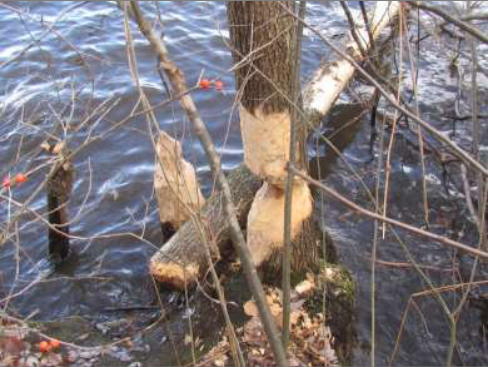
On the positive side, he cleared out the undergrowth, allowing room for the larger trees to flourish. He also provided us with an opportunity to plant some different trees in the open spaces. Some of his work was quite artistic and would make a nice oil painting. The next spring he did move back into the bush so our trees were safe.
Since both Sandy and I turn 80 this year, I think our beaver battles may have to come to an end. Pulling mud and sticks out of the culvert every day was exhausting and, coupled with the attack of the bald-faced hornets last summer, I came down with a virus that laid me up for three days with a temperature of 102.
On a side-note, that little deck pictured above, was left over from a cottage renovation the year before. We hauled it down to the shore and staked it down. The next spring the water came up and the deck floated away, Adirondack chairs and all. People on the other side of the lake said it was like a ghost ship, first floating one way, and then the other, before disappearing, never to be seen again.

But that’s another story – Sandy and Ernie.
Can you provide corrections or comments?
Please report technical issues to: